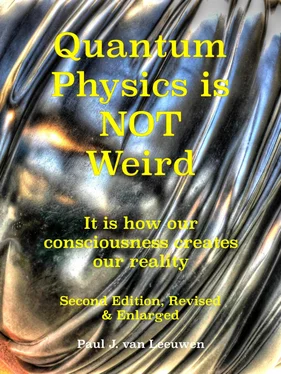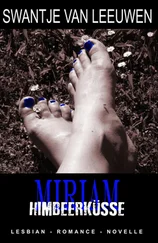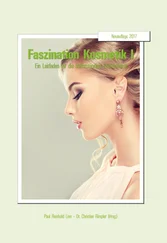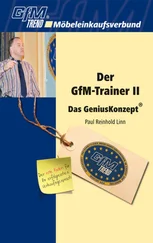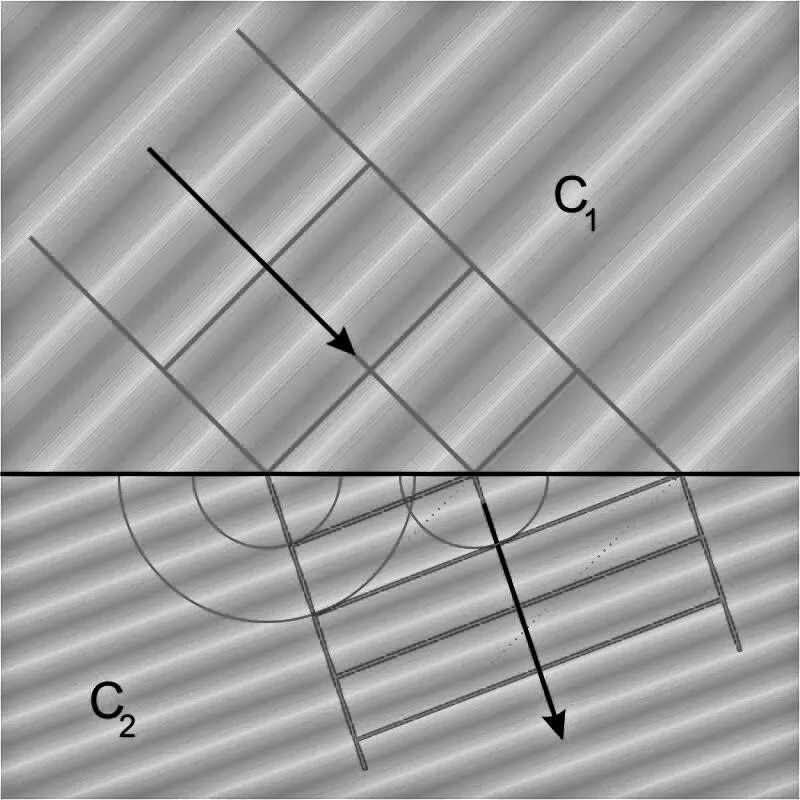
Figure 2.7: Huygens principle of light refraction.
Source: Wikimedia Commons.
The tangent line along the resulting circular wavefronts represents the new wave front. So the direction of the movement of the wave – drawn here with the black arrows, pointing perpendicular to the wave fronts – bends away from the boundary. According to Huygens, this explains Snell’s law [1 5 ]for the refraction of light waves.
So it was Huygens' idea that each point of a wavefront can be considered as a new elemental wave source expanding in a circular fashion and that the resulting wave would be simply the sum of all those elemental waves. However, he could not explain with this elementary wave model why the backwards expanding wave fronts from those elementary sources could not be treated in the same way.
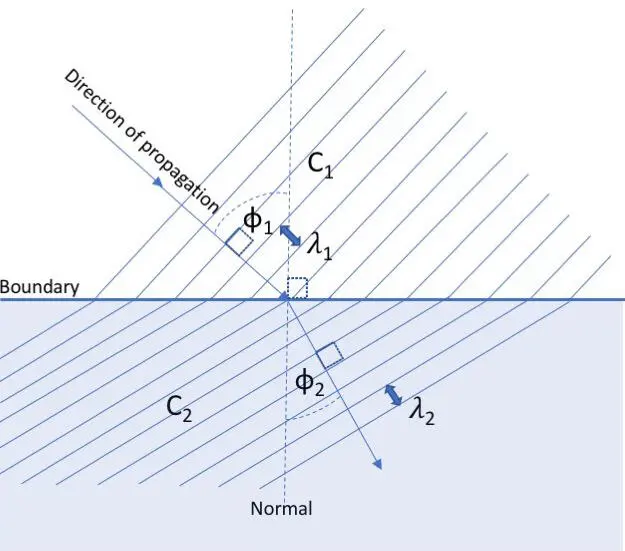
Figure 2.8: Wave refraction explained with contiguous wave fronts. φ 1is the angle of incidence, φ 2is the angle of refraction.
To understand Huygens’ wave refraction in another way, it is enough when you just think about the wavefronts having to be contiguous when crossing the boundary. The parallel lines in figure 2.8 depict the parallel traveling wavefronts. The waves in C 2do run slower than in C 1while their frequency remains the same, which means that their wavelength λ 2in C 2 has to be smaller than their wavelength λ 1in C 1. This should be clear from figure 2.8.
To remain both contiguous and parallel, the wave fronts entering C 2must change their direction at the boundary. In C 2 they will have to run more parallel to the boundary. The dashed line in figure 2.8, drawn perpendicular to the boundary between C 1and C 2, is called the normal. The angles with the normal, φ 1and φ 2, are called the angles of incidence and of refraction. You should understand from this that the angle of refraction is smaller than the angle of incidence when the wave speed is slower in medium C 2.
So, in general, when the wave speed is slower in the medium it enters, the wave fronts will tend to run more parallel to the boundary between the two media. This effect explains a phenomenon that you can easily observe walking along the beach. Perhaps you have noticed that incoming waves often will run almost parallel to the beach as they reach the shore. That is because the shallower the water, the slower the wave speed will be. Running slower and slower the closer they get to the shore, the wave fronts will, with each further slowing, change direction a little bit, finally running almost parallel to the shore.
We can imagine Huygens, living near the coast, wandering along the beach of The Hague enjoying the calming sound of the breaking waves while pondering the behavior of light. With his observant mind, he eventually noticed this wave phenomenon, which perhaps gave him the first inklings for his wave theory of light.
Huygens' wave theory of light has become high school curriculum, but you should realize that his model is purely a mathematical and mechanical model and therefore not necessarily in true accordance with reality. His contemporaries also expressed several objections:
Why is the new wave front formed by the tangent line to the elemental waves?
What happens to the parts of those circularly expanding elemental waves which do not participate in the new wave front?
Why don’t the backwards running elemental waves create backward running wave fronts?
How do circular elemental waves explain the observed linear propagation of light?
What is it that is oscillating, Christiaan?
So, the end of Newton’s corpuscle model was still a long way off. His theory of light corpuscles would last until 1803 when Thomas Young, through interference experiments with sunlight, demonstrated convincingly the wave character of light and presented his findings to the Royal Society in London.
3: The clockwork universe and the ether
“"A scientific truth does not triumph by convincing its opponents and making them see the light, but rather because its opponents eventually die, and a new generation grows up that is familiar with it." ~ Max Planck.”
Max Planck, first quantum physicist 1858-1947
In this chapter I will introduce you to the way how light was recognized as a wave phenomenon by the discovery of interference effects. This was one of the first moments in history where Newton’s ideas of the universe were severely contradicted. The acceptance of the idea of the wave character of light gave rise to speculations about what substance would carry the wave. An intangible ether was assumed at first. Electromagnetic effects were investigated and exactly measured in the first part of the 19 thcentury. Electric and magnetic fields were introduced as mathematical abstractions and quickly acquired the status of objectively existing phenomena.
Electromagnetic waves traveling with the velocity of light were predicted by Maxwell’s theory and were soon confirmed by experiment. Sophisticated attempts to measure the speed at which the earth would travel through the presumed ether failed utterly and confirmed thereby the predicted constancy of the speed of light, always exactly 186,282 miles per second regardless of the position and the movement of the observer.
At the brink of the twentieth century Max Planck solved the enigma regarding the radiation of a hot body by assuming exchange of electromagnetic energy in discrete amounts – quanta. His solution spelled the ultimate doom for the Newtonian vision of a 100% material universe.
Light as a wave phenomenon, interference, superposition
Thomas Young (1773-1829) let sunlight light shine through a double slit, mounted in one of the sides of a closed box. A piece of frosted glass was mounted at the opposite side of the double slit. The double-slit was manufactured by making two narrow parallel scratches on a soot-coated piece of glass. With this device he was able to observe the pattern that was projected by the light passing through the double slit. A pattern of colored light and dark bands appeared on the frosted glass at the back of the box. This was a phenomenon that could not be explained by Newton's light corpuscles. It could only be explained by assuming that light behaves like waves.
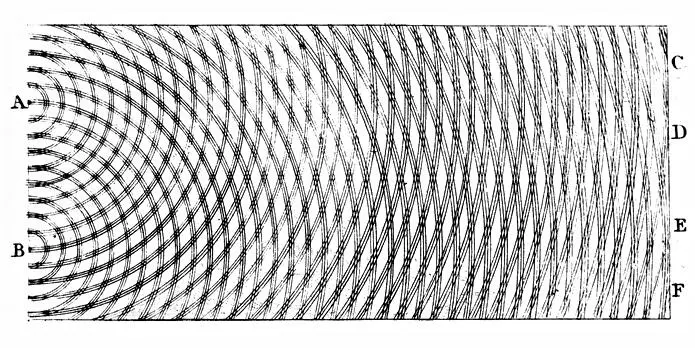
Figure 3.1: Youngs drawing of interference of monochrome light waves.
In 1803 Young presented his explanation of the results of his double-slit experiment to the Royal Society in London. He produced the above sketch to explain these dark and light bands, called fringes. The cause of these fringes is called interference. Light waves, coming from the left – not shown here – do arrive at the narrow slits A and B. In these slits two synchronously vibrating elementary wave sources are created, in the way Huygens had supposed. The two synchronous wave sources will generate circular wave fronts expanding from both slits. These synchronous circular expanding waves are necessarily moving exactly in phase and will have the same wavelength. Young's sketch represents the circularly expanding wave-fronts – the crests – of the supposed waves. Where these wave crests, expanding from slits A and B, intersect, they reinforce each other and create higher wave crests, maxima. Where the wave troughs – the minimum heights – extending from A meet the wave crests from B, or troughs extending from B meet crest from A, they will annihilate each other. In Young's sketch you can see that the intensity maxima will be found along lines fanning out from between the slits. These lines are formed by the intersections of the wave crests. Where those lines of maximum wave crests reach the screen (C-D-E-F), the light will show maximal intensity. Halfway in between these lines of maximum wave crests the light waves will annihilate each other so you will observe dark bands where these annihilation lines reach the screen. This reinforcing and annihilating phenomenon is called interference.
Читать дальше
